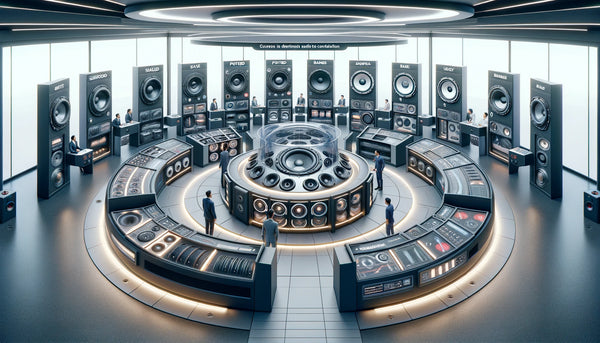Many enthusiasts seek bass in car audio systems. Bass adds depth, impact, and power to the music, immersing the listening experience. To achieve the desired bass response, the correct subwoofer box is essential. In this blog, we will examine ported subwoofer enclosures, their design, benefits, limitations, and how they compare to other subwoofer boxes.
What is a ported sub box, and how does it work?

A ported sub box, also known as a bass reflex enclosure, is designed to enhance a subwoofer's low-frequency response. It features a port or vent that allows the air inside the box to escape, creating a resonance effect that boosts bass output. This results in deeper and more impactful bass reproduction.
Understanding Subwoofer Boxes

Subwoofer enclosures, also known as subwoofer boxes, play a vital role in sound production. They provide the space and environment for the subwoofer driver to operate efficiently. Without the enclosure, the subwoofer driver would produce sound waves that cancel each other out, resulting in a muffled bass response.
The Role of Subwoofer Boxes in Sound Production
The subwoofer box serves several purposes in sound production. First, it helps control sound waves, ensuring accurate bass reproduction. Second, by containing the sound waves within the enclosure, the box prevents interference from the front and back of the subwoofer driver, resulting in cleaner audio output.
Additionally, the subwoofer box ensures that the subwoofer driver operates within its optimal frequency range. Different subwoofer drivers have different frequency response specifications, and the right enclosure design helps the subwoofer driver stay within those specifications, preventing sound distortion.
Moreover, subwoofer enclosures also contribute to the subwoofer's bass response. The internal volume of the box, as well as the area of the port (if present), directly affects the bass response of the subwoofer driver. Properly designing the enclosure volume and port area can help the subwoofer achieve deeper bass extension and more low-frequency output.
Different Types of Subwoofer Boxes

There are various subwoofer enclosures, each with its own characteristics and sound qualities. The most common types include sealed, ported, bandpass, and free-air subwoofer enclosures.
sealed subwoofer enclosures, also known as sealed boxes, are known for their accurate bass response and sound quality. They provide a more balanced bass response for all music genres, including hard rock. Sealed enclosures are less affected by the car's environment, resulting in more consistent bass performance. However, sealed enclosures may require more power to achieve the same bass volume as ported enclosures.
Ported subwoofer enclosures, also called vented enclosures, offer a more profound bass response and increased low-frequency output than sealed enclosures. The ported box design allows the subwoofer driver to interact with the enclosure volume, resulting in more volume and bass impact. Ported enclosures can be up to twice as big as a comparable sealed box since the airspace inside the chamber is substantially larger. Ported enclosures are more efficient, requiring less power to produce the same bass volume as sealed enclosures. However, ported enclosures may require more space, both internal box volume and port area, limiting installation options.
Bandpass subwoofer enclosures combine sealed and ported enclosures, creating a unique sound experience. The sealed enclosure filters out the higher frequencies, allowing only the lower frequencies to pass through the ported enclosure, resulting in more volume and profound bass response. Bandpass enclosures require careful tuning to ensure optimal sound quality, as the combination of sealed and ported enclosures can affect the frequency response.
Free-air subwoofers, or infinite baffle enclosures, operate without an enclosure. Instead, they utilize the space behind the subwoofer driver, such as the trunk of a car, to create the necessary bass response. Free-air subwoofers are space-saving options, as they don't require a dedicated enclosure. However, the bass response may not be as robust as enclosure-based subwoofers.
Each subwoofer box type has advantages and limitations, catering to different audio preferences and space availability.
Deep Dive into Sealed Subwoofer Boxes

Sealed subwoofer enclosures, also known as sealed boxes, are famous for their accurate bass response and sound quality. Let's examine their characteristics, pros and cons, and the reasons why they might be the right choice for you.
Characteristics of Sealed Subwoofer Boxes
Sealed subwoofer enclosures deliver a more balanced bass response, suitable for all music genres. They provide accurate low-frequency reproduction, preserving the dynamic range of audio material. The sealed box design completely seals the woofer driver and prevents sound waves from the front and back of the driver from interfering with each other, resulting in more apparent audio output.
Sealed subwoofer enclosures are less affected by the car's environment, such as the interior volume or trunk space, providing more consistent bass performance regardless of the car's acoustics. They are an excellent choice for audio enthusiasts seeking accurate sound quality in various listening environments.
The cubic feet volume of the sealed subwoofer enclosure directly affects the subwoofer driver's response. It is crucial to match the enclosure's internal volume with the subwoofer driver's specifications, ensuring optimal bass reproduction. Additionally, the material of the sealed box, often medium-density fiberboard (MDF), contributes to the enclosure's sound quality and durability. The frequency range that a subwoofer can reproduce under normal circumstances, denoted in Hertz (Hz), is an important consideration when designing a sealed subwoofer box.
Are there any drawbacks to using a ported subwoofer box instead of a sealed enclosure?
While ported subwoofer boxes offer deeper bass and higher efficiency, they can be larger and more complex to design. They may also lack the precise sound reproduction of sealed enclosures and require more power to operate effectively.
Pros and Cons of Sealed Subwoofer Boxes

Sealed subwoofer enclosures offer several advantages in bass reproduction. First, they provide an accurate bass response, resulting in more defined and controlled low frequencies. Second, the sealed box design reduces the risk of sound distortion, ensuring cleaner audio output.
Sealed subwoofer enclosures are generally more compact, requiring less space than ported enclosures with comparable power handling capabilities. This makes sealed enclosures more suitable for car audio systems with space limitations or for audio enthusiasts who prefer a more subtle bass response.
However, sealed subwoofer enclosures may require more power to achieve the same bass volume as ported enclosures. Since the sealed enclosure completely seals the subwoofer driver, the subwoofer needs more power to move the air and produce the desired bass volume. Therefore, sealed enclosures may not be ideal if you're seeking a more profound bass response.
Sealed subwoofer enclosures suit audio enthusiasts seeking precise sound quality over more profound bass response. They excel in accurate bass reproduction and provide more controlled low frequencies, making them the preferred choice for genres such as jazz, classical, or acoustic music.
Exploring Ported Sub Boxes

While sealed subwoofer enclosures are great for accurate sound quality, ported subwoofer enclosures offer a more profound bass response and increased low-frequency output. Let's explore the world of ported subwoofer enclosures, their design, benefits, and limitations.
Understanding the Design of Ported Sub Boxes
Ported subwoofer enclosures, also called vented sub box, utilize the ported box design, which allows the subwoofer driver to interact with the enclosure volume. In ported enclosures, the subwoofer driver's sound waves are combined with the sound waves from the port, resulting in a more profound bass response, especially in the lower frequency range. Ported enclosures are commonly used in vehicles that compete in SPL (Sound Pressure Level) competitions, where the loudness of a vehicle's sound system is measured in decibels or dBs. This enclosure design enhances the overall sound performance and delivers powerful bass.
The volume of the ported enclosure, the port's area, and the port's length all play crucial roles in determining the bass response of the subwoofer driver. Proper box volume specifications, port area, and length calculations are necessary to achieve the desired bass frequency response. The ported box design complements the subwoofer driver, allowing more air movement and increasing sound volume and bass extension.
Proper vented sub-box construction, internal volume, and port area are crucial for the optimal performance of ported enclosures. The ported enclosure must be sealed correctly, ensuring that the only way for the sound waves to escape is through the port, maximizing bass response.
Benefits and Limitations of Ported Sub Boxes

Ported subwoofer enclosures offer several benefits regarding bass response. Firstly, they provide a more profound bass response, delivering more low-frequency impact and power. The ported box design allows the subwoofer driver to move more air, resulting in louder sound volume and more bass extension.
Ported subwoofer enclosures are more efficient than sealed enclosures, requiring less power to produce the same bass volume. This makes ported enclosures an excellent choice for car audio systems with lower-power amplifiers, as they can still achieve the desired bass response without straining the amplifier.
However, ported subwoofer enclosures may require more space, both internal box volume and port area, than sealed enclosures with comparable power handling capabilities. This can limit the installation options, especially in vehicles with limited space for subwoofer enclosures.
Furthermore, ported subwoofer enclosures may sound less accurate than sealed enclosures, as the emphasis is more on bass volume than sound quality. While ported enclosures can provide a more profound bass response, the sound quality may not be as precise, especially in the lower frequency range.
Comparing Sealed and Ported Sub Boxes

Now that we have explored the characteristics of dual-sealed and dual-ported subwoofer enclosures let's compare the sound quality and performance of the two types and understand their differences.
Sound Quality Comparison
The type of enclosure plays a significant role in sound quality. Sealed mdf subwoofer enclosures, with their more balanced bass response, provide accurate bass reproduction suitable for all music genres. They excel in preserving the dynamic range of audio material, resulting in more defined low frequencies.
On the other hand, ported subwoofer enclosures offer a more profound bass response than sealed enclosures, emphasizing bass volume and low-frequency impact. The ported box design allows the subwoofer driver to move more air, resulting in more volume and bass extension, especially in the lower frequency range.
Depending on your sound preference, both sealed and ported enclosures have advantages. If accurate bass reproduction and sound quality are paramount, sealed enclosures are the way to go. However, if you seek a more profound bass response and more low-frequency power, ported enclosures will be more suitable.
Performance Comparison

In terms of performance, sealed subwoofer enclosures are known for their accurate bass response, making them suitable for all types of music genres. They excel in preserving the dynamic range of audio material, ensuring more controlled low frequencies.
Ported subwoofer enclosures, on the other hand, offer a more profound bass response and better low-frequency extension than sealed enclosures. The ported box design allows the subwoofer driver to move more air, resulting in louder sound volume and more impactful bass.
When choosing between sealed and ported mdf subwoofer enclosures, it is crucial to consider the enclosure's power handling capabilities and the specifications of the subwoofer driver. Sealed enclosures may require more power to achieve the same bass volume as ported enclosures, while ported enclosures can provide a more profound bass response more efficiently. In equal volume mode, auditioning speakers before you buy can give you a more direct comparison of subtle voicing differences between speakers.
In-depth Look at Bandpass Subwoofer Boxes

Bandpass subwoofer enclosures offer a different approach to bass response, combining the characteristics of sealed and ported mdf enclosures. Let's explore the world of bandpass subwoofer enclosures, their design, advantages, and disadvantages.
Understanding Bandpass Subwoofer Boxes
Bandpass subwoofer enclosures combine two types of enclosures: sealed and ported enclosures. This unique design allows the subwoofer driver to operate within the sealed enclosure. In contrast, the ported enclosure amplifies the bass frequencies, resulting in more volume and a more profound bass response.
The bandpass system's sealed enclosure filters out the higher frequencies, allowing only the lower frequencies to pass through the ported enclosure, emphasizing the bass response. This combination of sealed and ported enclosures creates a unique sound signature, providing more focused bass reproduction.
Advantages and Disadvantages of Bandpass Subwoofer Boxes

Bandpass subwoofer enclosures offer several advantages for bass response. Firstly, they provide increased bass output, more volume, and a unique sound experience compared to sealed and ported enclosures. The combination of sealed and ported enclosures allows the subwoofer driver to operate more efficiently, resulting in more bass impact.
MDF Bandpass enclosures are more space-efficient than ported enclosures with the same power-handling capabilities. This makes them suitable for car audio systems with limited space for subwoofer enclosures, as the space required is less than ported enclosures.
However, bandpass subwoofer enclosures can be more challenging to design than sealed and ported enclosures, as the tuning process can be more time-consuming. The right sound quality and frequency response require accurate enclosure volume, port area, and port length specifications. Improper tuning of the bandpass enclosure can result in less accurate bass response, emphasizing volume over sound quality.
Before choosing a bandpass subwoofer enclosure, it is crucial to consider the advantages and disadvantages, as well as the sound quality and bass response you desire.
Comparing Bandpass and Ported Sub Boxes

There are several factors to consider when comparing dual bandpass and ported sub-boxes. Bandpass boxes are known for their efficiency and ability to produce high sound pressure levels. They use a combination of a sealed enclosure and a ported chamber to achieve this. On the other hand, ported sub-boxes are designed to enhance low bass response and provide a more extended frequency range. They use a port or vent to create a resonance effect that boosts the low-frequency output. Both types of enclosures have advantages and disadvantages, so choosing the right one is essential based on your specific needs and preferences.
Sound Quality and Performance Comparison
Bandpass subwoofer enclosures, with their unique design, prioritize bass volume and low-frequency impact. The combination of sealed and ported enclosures amplifies more bass frequencies, resulting in more volume and a more profound bass response than ported enclosures.
Ported sub boxes, on the other hand, balance sound quality and bass volume. While they may not offer the same bass volume as bandpass enclosures, ported enclosures excel in deeper bass extension, especially in the lower frequency range.
When choosing between bandpass and ported subwoofer enclosures, it is crucial to consider the sound experience you desire. If more volume and bass impact are essential, a bandpass subwoofer enclosure may be the right choice for you. However, if a more profound bass response and more accurate sound quality are your priorities, a ported subwoofer enclosure is worth considering.
Choosing Based on Your Sound Preference

When selecting the proper subwoofer enclosure, consider your sound preference and your desired listening experience. A bandpass subwoofer enclosure might be the right choice if you prefer more volume and bass impact. The bandpass system's combination of sealed and ported enclosures provides more bass volume, resulting in a more powerful sound experience.
On the other hand, if you seek accurate bass response and a balanced sound, a ported subwoofer enclosure is worth considering. Ported enclosures offer a more profound bass response, providing more low-frequency impact and power while maintaining sound quality.
When choosing the proper subwoofer enclosure, consider the type of music you listen to, the available space in your car, and the power requirements of the subwoofer driver. Experimenting with different enclosure types will help you find the sound that best suits your preferences. Consulting audio experts or car audio professionals can provide personalized recommendations based on your sound preference and the specifications of your audio system. How much space you have available or are willing to give up to install a subwoofer can decide whether you choose a ported or sealed enclosure.
Free-Air Subwoofers: An Alternative

While sealed, ported, and bandpass subwoofer enclosures are the most common types, another alternative is available - free-air subwoofers. Let's explore the world of free-air subwoofers, their design, and how they compare to ported subwoofer enclosures.
What are Free-Air Subwoofers?
Free-air subwoofers, or infinite baffle enclosures, are designed to operate without an enclosure. Instead, they utilize the space behind the subwoofer driver, such as the trunk of a car, to create the necessary bass response. Using the car's environment, the subwoofer driver produces bass frequencies, similar to how sound waves are produced in pipe organs or comparable sealed enclosures.
Free-air subwoofers require a solid mounting surface, such as the rear deck, to isolate the sound waves from the front and rear of the subwoofer driver and prevent sound cancellation. This mounting surface acts as a baffle, allowing only the bass frequencies to pass through while blocking the higher frequencies.
Free-air subwoofers are space-saving options, as they don't require a dedicated enclosure. This can benefit car audio systems with limited space for subwoofer enclosures. However, the bass response of free-air subwoofers may not be as robust as enclosure-based subwoofers, as the subwoofer driver relies on the car's environment for bass production.
When considering free-air subwoofers, it is crucial to evaluate the available space in your car, the desired bass response, and the installation requirements, including the necessary baffle material, to ensure optimal sound quality.
Comparing Free-Air Subwoofers with Ported Sub Boxes
There are notable differences in bass response and sound quality when comparing free-air subwoofers with ported subwoofer enclosures.
A ported sub box provides a more profound bass response than free-air subwoofers. With its ported enclosure volume, the ported box design allows the subwoofer driver to move more air, resulting in deeper bass extension and low-frequency impact.
On the other hand, free-air subwoofers rely on the car's environment to produce bass frequencies, which may not match the power and volume of ported subwoofer enclosures. While free-air subwoofers offer a space-saving option, the bass response may not be as impactful as enclosure-based subwoofers.
If a more profound bass response and low-frequency power are essential, ported subwoofer enclosures are the way to go. They enhance the overall listening experience, providing more volume and bass impact. Choosing the right ported subwoofer box, considering enclosure volume, port area, and specifications of the subwoofer driver, can significantly improve the bass performance of your car audio system.
Factors to Consider when Choosing a Subwoofer Enclosure

When selecting the correct subwoofer box, there are several factors to consider. The size of the subwoofer, the space availability in the vehicle, and the desired sound quality all play crucial roles in the decision-making process. Let's take a closer look at these factors.
Size of the Subwoofer
The size of the subwoofer box should be compatible with the subwoofer driver. Larger subwoofers generally require bigger enclosures to perform optimally, as they require more internal volume to move the necessary amount of air for bass response. Conversely, smaller subwoofers may not require as much internal volume, allowing for more space-saving enclosure options.
It is crucial to match the internal volume of the subwoofer box with the specifications of the subwoofer driver, as the enclosure volume directly affects the subwoofer driver's response. This ensures accurate bass reproduction, maximizing the subwoofer's potential.
Space Availability in the Vehicle
Considering the available space in the vehicle is essential when selecting the size of the subwoofer box. Compact car interiors may require smaller subwoofer enclosures, allowing more space inside the car. On the other hand, larger vehicles with more available space can accommodate larger subwoofer enclosures, providing more bass volume and impact.
Maximizing available space allows for larger subwoofer enclosures, which can enhance the bass response and overall listening experience. It is essential to plan the subwoofer box size according to the available space in the desired location, ensuring a proper fit and optimal bass response.
Desired Sound Quality
The desired sound quality is another crucial factor when choosing a subwoofer box. Different enclosure types offer different sound characteristics, and selecting the correct box can significantly impact the sound experience.
Ported subwoofer enclosures, with their more profound bass response, excel in delivering more low-frequency impact and power. If accurate bass response and deeper bass extension are paramount, ported enclosures may be the way forward.
Sealed subwoofer enclosures, however, provide more accurate bass reproduction, suitable for all types of music genres. They offer a more balanced sound, preserving the dynamic range of audio material, making them an excellent choice for audio enthusiasts seeking accurate sound quality.
Considering the listening environment, the source material, and the sound experience you desire will help determine the correct subwoofer box for your car audio system. Experimenting with different enclosure types and seeking the advice of audio experts or car audio professionals can provide personalized recommendations based on your sound preference.
Building Your Bass System

Now that we have explored the different types of subwoofer enclosures and factors to consider, let's look closer at building your bass system. We will discuss the essential components, step-by-step guide, and maintenance tips to ensure the longevity of your subwoofer box.
Essential Components for a Bass System
Building a bass system requires several essential components. These include the subwoofer, amplifier, enclosure, wiring, and power distribution. Let's take a closer look at each of these components.
The subwoofer is the primary driver of the bass system, responsible for low-frequency reproduction. It is available in various sizes, power ratings, and specifications, allowing you to choose the right subwoofer driver for your sound preferences.
An amplifier provides the power to drive the subwoofer, ensuring optimal bass response. The amplifier should match the power specifications of the subwoofer driver, providing the necessary power without over or under-powering the subwoofer.
The subwoofer enclosure, such as a ported sub-box, is crucial for bass response, as discussed earlier in the blog. Choosing the proper enclosure specifications, including internal volume, port area, and port length, ensures accurate bass reproduction and the desired bass response.
Proper wiring and power distribution are necessary to ensure the optimal performance of the bass system. This includes selecting the correct gauge of wiring, ensuring proper connections, and distributing power effectively to the amplifier and subwoofer driver.
Step-by-step Guide to Building a Bass System

Building a bass system requires careful planning and execution. Here is a step-by-step guide to help you build your bass system:
- Determine the available space in the vehicle for the subwoofer box. Consider the car's interior volume, the available trunk space, and the desired location for the subwoofer enclosure.
- Choose the proper subwoofer box specifications based on the subwoofer driver and the desired sound quality. Consider the internal volume, port area, port length, and enclosure material, ensuring compatibility with the subwoofer driver's specifications.
- Install the subwoofer box, driver, amplifier, and wiring following the manufacturer's instructions. Ensure proper wiring connections, secure enclosure installation, and accurate port length specifications for ported enclosures.
- Adjust the bass system settings, such as the crossover frequency and gain, for optimal sound quality. Fine-tune the frequency response of the subwoofer driver, ensuring seamless integration with the car audio system.
- Perform sound testing and make necessary adjustments to achieve the desired bass response. Experiment with different audio materials, listening volumes, and sound sources to evaluate the performance of the bass system.
These steps will help you build a bass system that delivers the desired sound quality and bass response, enhancing your car audio experience.
Maintenance Tips for Your Woofer Box

To ensure the longevity of your subwoofer box, regular maintenance is necessary. Here are some maintenance tips to keep your subwoofer box in excellent condition:
Routine Checks and Cleaning
Regularly check the subwoofer box for any signs of damage, such as cracks, loose screws, or sealed enclosure integrity. Inspect the box material, ensuring there are no structural issues that may affect the sound quality or durability of the enclosure.
Cleaning the subwoofer box helps maintain sound quality and prevents the buildup of dirt and debris, which can affect bass response. Remove the subwoofer driver, if possible, and clean the enclosure using a soft, dry cloth or a vacuum cleaner with a soft brush attachment. Avoid using liquid cleaners, as they may damage the enclosure material.
Inspect the wiring connections, ensuring they are secure and free of corrosion. Loose or corroded wiring can affect the performance of the subwoofer driver, resulting in sound quality issues or subwoofer failure.
Keep the subwoofer box away from direct sunlight, excessive heat, or moisture, as these environmental factors can damage the enclosure material, affect the sound quality, or cause the subwoofer driver to overheat.
Performing routine checks and cleaning the subwoofer box will prolong its lifespan, ensuring optimal sound quality and bass response.
Ensuring the Longevity of Your Subwoofer Box

Ensuring the longevity of your subwoofer box requires proper enclosure selection, installation, and maintenance. Consider the following tips to maximize the lifespan of your subwoofer box:
Choose a ported sub-box made from durable materials, such as a medium-density fiberboard (MDF), that can withstand the stress of bass vibrations. High-quality enclosures provide better sound quality, durability, and bass response than lower-quality enclosures.
Properly seal the subwoofer driver in the box, ensuring no air leaks, as this can affect the sound quality and bass response. Ensure the subwoofer driver is securely mounted, preventing any movement that may cause damage to the driver or enclosure material.
Install the subwoofer box in an appropriate location, away from areas of direct moisture, excessive heat, or extreme temperatures, as these environmental factors can damage the enclosure material, affecting sound quality and bass response.
Avoid over-powering or under-powering the subwoofer, as this can cause damage to the subwoofer driver, decreasing its lifespan. Ensure the amplifier power matches the specifications of the subwoofer driver, providing the necessary power without straining the subwoofer or amplifier.
Regularly clean and maintain the subwoofer box, preventing the buildup of dust and debris, which can affect sound quality, bass response, and the internal environment of the enclosure.
Following these tips will help ensure the longevity of your subwoofer box, optimizing sound quality, bass response, and the overall listening experience of your car audio system.
Expert Opinions on Ported Sub Boxes

Now, let's turn to expert opinions on ported subwoofer enclosures, gaining insights from top audio professionals and audio experts. Their experience and expertise can provide valuable insights into the benefits of ported subwoofer enclosures.
Reviews from Top Audio Experts
Renowned audio experts have praised ported sub boxes for producing deep, accurate bass. They have commended the vented enclosure design for great sounding low-frequency response, providing more bass volume and impact compared to sealed enclosures of comparable power handling capabilities.
Top audio professionals have noted the ported subwoofer enclosure's excellent sound quality, low bass response, and power handling capabilities, making them an ideal choice for car audio systems seeking more bass impact and reliable shipping, especially when placed under the rear seat. The ported box design, with its ability to move more air, results in more volume, deeper bass, and a more immersive sound experience.
According to audio experts, ported subwoofer enclosures excel in sound quality, power, and low-frequency response, making them the preferred choice for bass enthusiasts, especially in genres like hip-hop, EDM, and rock, where more profound bass response is desired.
Why Choose a Ported Sub Box Over Others?

Are you looking for deeper bass and a more impactful low-frequency experience? Consider a ported subwoofer enclosure. It allows the subwoofer to move more air, resulting in louder sound output and increased bass volume. With the correct specifications, ported enclosures can deliver accurate bass reproduction. Perfect for bass enthusiasts who love genres like hip-hop, EDM, and rock, a ported sub-box enhances your overall listening experience. The port redirects sound from the cone's rear and adds it to the sound from the front, making the bass louder. This increase in efficiency lets you use a smaller amp than you would need with a comparable sealed box to play at the same volume.
Frequently Asked Questions in Ported & Vented Subwoofer Boxes
When it comes to ported and vented subwoofer boxes, enthusiasts often have a variety of questions. These inquiries typically revolve around the differences between sealed and ported designs, the benefits of using a ported box, and how to select the right one for their audio setup. Understanding these frequently asked questions can help clarify the advantages and limitations of ported sub boxes, allowing users to make informed decisions that enhance their overall sound experience.
Ported & Vented Subwoofer Boxes FAQs
What exactly is a ported sub box, and how does it differ from a vented box? Essentially, a ported sub box is designed to enhance the audio experience by allowing air to flow in and out, delivering deeper bass. When comparing it to a vented box, both designs aim to improve bass output; however, they may differ in construction specifics. Whether you're a casual listener or an audio enthusiast, understanding the nuances of these subwoofer types can significantly impact your audio experience.
Conclusion
To sum up, when it comes to subwoofer boxes, there are different types, each with advantages and limitations. Sealed subwoofer boxes offer precise and accurate sound reproduction, while ported subwoofer boxes provide deeper bass and increased efficiency. Bandpass subwoofer boxes offer sealed and ported designs for enhanced performance in specific frequency ranges. Free-air subwoofers provide a space-saving alternative for those with limited installation options.
When choosing a subwoofer box, consider factors such as the size of the subwoofer, available space in your vehicle, and desired sound quality. Building a bass system requires essential components like the subwoofer, amplifier, and appropriate wiring. Regular maintenance and cleaning will ensure the longevity of your subwoofer box.
In conclusion, understanding the different types of subwoofer boxes and considering your specific needs and preferences will help you make an informed decision. To learn more about building the perfect bass system, check out our comprehensive guide in our next blog.






